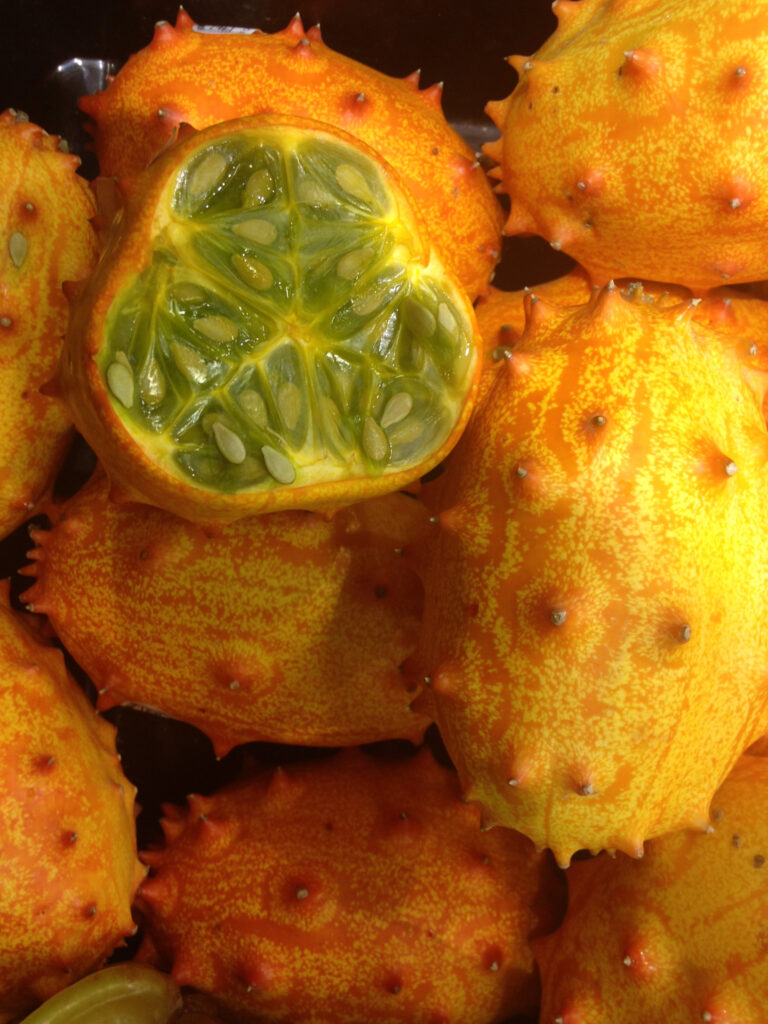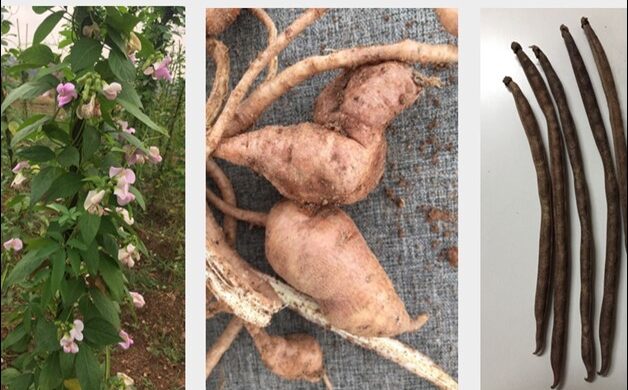African yam bean (Sphenostylis stenocarpa)
The African yam bean belongs to the family Leguminosae. The annual climbing or prostrate vine is mainly grown for its fleshy roots that looks like a sweet potato. It flourishes throughout tropical Africa, where both seed and tuber are important components of the diet. It is not well known as a food source outside Africa, although it is used as an ornamental plant in Europe and elsewhere.
It is different from Mexican yam or yam bean that grows in Central and South America, and especially in Mexico and Brazil. There, this tuberous vine is grown mainly for the tuber because the seeds are toxic. In nutritional terms, the African yam bean contains more than twice the protein of sweet potatoes, yams, or potatoes, and more than ten times that of cassava. The protein is of exceptional nutritional quality, which complements the proteins of maize, sorghum, and the other staples.

The fruit of the horned melon is rich in Vitamin C and fibre.
Cultivation
The abundance of seeds and leaves are edible, and the plant seems capable of delivering record quantities of protein from soils normally considered marginal. In the traditional farm setting it is usually interplanted with yams and other vegetables in the traditional village farm setting. The vine produces linear pods of between twenty and thirty centimetres long, each bearing twenty to thirty oval seeds that are usually cream, orangebrown, brown, or mottled brown. Flowering occurs 80 to 130 days after planting, while the seeds reach maturity after 150 to 300 days. In poor soil, the seed yield is about 300 to 500 kg/ha, but higher yields of between 2 000 and 3 000 kg/ha have been reported for fertile soils.
The plant yields tubers of 100 to 300 g/plant, with hectare yields estimated at about 2 000 kg in fertile soils. The African yam bean grows best in areas where annual daytime temperatures are within the range of 23 to 29 ° Celsius, but it can tolerate 15 to 35 ° Celsius. It prefers a mean annual rainfall in the range 1 000 to 1 200 mm, but tolerates 800 to 1 400 mm.
The plant requires a dry period when it is flowering. It prefers a position in full sun. It grows best in a fertile sandy soil and prefers a pH in the range 5,5 to 6, but tolerates 4,5 to 7. Although perennial, the plant is usually treated as an annual in cultivation. Plants are probably day length sensitive. The seedpods can be harvested about five months after sowing and continue for another two months. The tubers mature seven to eight months after sowing. It is best to leave the roots in the ground when removing plant material at the end of the growing season, as the decaying roots release their nitrogen.

The flowering yam bean plant, the tubers and the slender pods.
Horned melon (Cucumis metalliferus)
Cucumis metalliferous, commonly called the African horned melon or horned cucumber, spiked melon, jelly melon, kiwano, or cuke-a-saurus is an annual vine in the cucumber and melon family, Cucurbitaceae.
It is a traditional food plant indigenous to Southern and Central Africa and grows naturally in Namibia, Botswana, South Africa, and Swaziland. It is nowadays also grown all over the world for its ornamental and edible fruits, including in New Zeeland where it was registered under the trademark Kiwano. The horned melon is grown as an annual in cold areas and needs well-drained soil, regular watering, and support to climb on. A single vine can produce up to a hundred fruits. It is a self-fertile climber that does not need other similar plants for pollination. It has hairy leaves and stems and bears white or yellow flowers. It attaches itself to support by means of tendrils. The soft-shelled fruit is about ten centimetres in length and is covered with prominent spines.
It turns yellow-orange when ripe. The fruit can be eaten at any stage of development, from young, or mature but still green, or when ripe. The juicy sweetish flesh is green and translucent and contains a lot of seeds covered in a gelatine-like substance. It tastes like a combination of cucumber and zucchini, or a combination of banana, cucumber, and lemon. It can be eaten fresh when cut open and sprinkled with sugar or salt, scooped out of the shell, and used in a fruit salad, or juiced.
The leaves, fruit and seeds are edible. The fruit can be boiled until soft, strained and the liquid boiled with a cup of sugar for each cup of liquid to produce jelly. The fruit can also be cubed and pickled in vinegar. The Khoisan roast the food and then strain the flesh. The leaves are either cooked like spinach or mixed with maize meal. The fruit contains saponin, an oily glycoside that foams when shaken with water.
Nutritional value
The skin is very rich in Vitamin C and fibre.
Cultivation
Plant the horned melon seeds in rich, well-drained soil in full sunlight near a trellis or fence to promote climbing. The plant is not very particular regarding soils but prefers clay or loamy soil with a pH range of 6 to 6,5. Sow seeds in the spring when temperatures are above 20° Celsius. Plant two or three seeds at a depth of two to three centimetres, leaving sixty centimetres between groups of seeds. Allow about 1,8 m of space between rows. Keep the soil moist down to about three centimetres to aid germination, which occurs within two or three weeks.
Once the plant is established, water slowly and deeply in the morning or afternoon. Provide it with two to five centimetres of water per week, soaking down to about fifteen centimetres, allowing the soil to dry between waterings. General-use fertiliser with a 4-8-5 or 6-10-10 N-P-K ratio can be applied according to the manufacturer’s instructions. When the soil temperature is above 24 ° Celsius, you can apply organic mulch, such as straw or wood chips, around the base of the plant to help retain moisture and prevent weed growth. Weeds can be removed by hand.

The horned melon is a traditional food plant of Africa that is nowadays cultivated worldwide.
Contact details
Jurie van der Walt at jurievdw@ mweb.co.za. His books are freely available on request. The history of food and why we eat it (2020), and We need to revive the ancient indigenous food crops of Africa (2021)
Resources:
Nwokolo, E., (n.d.) African yam bean (Sphenostylis stenocarpa (Hoechst ex. A. Rich.) Harms.) Food and feed from legumes and oilseeds. Pp 182-188 DOI: 10.1007/978-1-4613-0433-3_18 https://link.springer.com/chapter/10.1007/978-1-4613-0433-3_18









